The 2012 annual tour by the County Kildare Archaeological Society took place over 3 days to East Cork and West Waterford on 14, 15 and 16 June taking in visits to Youghal, Lismore and Cobh. The tour leader was Hugh Crawford, Vice President of the Society, who with more than a little help from Patrick Guinness, Council member, drew up a schedule of leading historical, archaeological and heritage sites to be visited. The Garryvoe Hotel directly overlooking the beautiful Ballycotton Bay and Garryvoe Strand was selected as the base for the duration of the tour.
Day 1 Thursday 14th June:
En-route, various monuments, castles, family seats, landscapes and historical events were outlined and discussed. The historic town of Mitchelstown was the first site on the scheduled tour. It was selected as an example of a well-built and designed town having similarities to Co. Kildare towns such as Maynooth, Kildare and Monasterevin being the creation of the great landowning families. Mitchelstown is located in the heart of the Golden Vale and is currently a busy market town.
Stopping in King’s Square, the group were apprised of the magnificent Georgian architecture, the beautiful open landscaped space with careful tree planting leading to the entrance gate and avenue to the former Mitchelstown Castle. On the north side of the Square is the famous Kingston College, the building of which, resulted from the provision of an endowment of £25,000 in a family Will. The complex consists of a chapel and college of almshouses for poor members of the Church of Ireland or as described decayed gentlewomen and gentlemen. Building works began around 1770 under the architect John Morrison. A total of 22 houses were built with the chapel and Chaplin’s house in the centre and with later refurbishment this number was increased to 31 units. A number of the King family are buried in a vault beneath the chapel. During the drive-through, note was made of the medieval town having been replaced with a new town with a simple but impressive street pattern with the King family names prominent on many of these Streets. In keeping with the plan a Demesne of 1,200 acres was enclosed by the building of a 10 feet high stone wall over 6 miles which took 16 years to build at a cost of £16,000. The intrinsic street pattern was evident while passing along the beautiful tree-lined George’s Street joining King’s Square. Departing from the town remnants of the former demesne wall were visible as was the former Military Barracks, like the Castle burned in 1922.
Mitchelstown has a long and interesting past, archaeological excavations carried out recently in the former town’s demesne, during the construction of the town’s bypass, provided evidence of habitation in this area dating back to around 2,000 BC. The findings include a Bronze Age cooking site, a medieval corn-drying kiln and a polypot depicting a human face. The town of Mitchelstown owes its origin to the 13th Century Norman family named ‘de St Michel’ which had a strong devotion to Michael the Archangel and their village became known as Villa Michel. In the early 17th century the name had evolved into the Gaelic name of Ballyvisteal which was later anglicised to its present name of Mitchelstown. Around the middle of the 14th century the de St Michel family estates passed to the FitzGibbons who were a branch of the Geraldines which included the earls of Kildare and the earls of Desmond. In the early 17th century due to there being no male heir, ownership passed to a daughter Margaret who at 11 years of age married Sir William Fenton in an arranged marriage. She had an inheritance of 100,000 acres which passed on her death to her daughter Catherine, the sole surviving member of her marriage. Catherine, who inherited the estate in the 1650s, married Sir John King, a distinguished Cromwellian officer during the English Civil War, and so began the King dynasty which would last for well over 200 years. The Kings would become – Barons and Earls of Kingston and through marriages with their Boyle cousins would amass massive estates both in Munster and Connaught. They engaged in a wide range of activities including inappropriate conjugal relationships, religion practices and the establishment of freemasonry. They also brought leading architects, writers, artists and for a period of time employed the great agriculturist Arthur Young, famous for his journal on his tour of Ireland in the late 18th century. The whole empire unravelled with the lack of direct heirs, poor management, bankruptcy, the famine and of course the Land War. The final blow came with the burning of Mitchelstown Castle in 1922 during the Civil War. While the King family may not be remembered in terms of endearment by all the people of Mitchelstown, however, they did leave a great legacy in terms of structures , streets and squares for future generations to enjoy.
Immediately after leaving Mitchelstown the military training lands of Kilworth were pointed out. Around 7,000 acres were acquired by the British War Department in the early 1890s mainly from the Kingston and Mount Cashell estates which was a boost to these family finances. These lands are now divided between the Irish Defence Forces and the Irish Forest Service – Coillte. The construction of Kilworth Camp brought commercial development to the area including the Imperial Hotel which provided entertainment and accommodation for senior British army officer on visits to the Camp at that time. In later years as motor transport developed it became a favourite stopping point and its name changed to the Blue Lagoon and in more recent times to the Corbett Court. It was here that the party took a most delightful break, made the more enjoyable by a very hospitable staff, who served beautiful tea and scones prior to proceeding to the next scheduled stop at Labbacallee.
On the way to Labbacallee, Moorepark Research Centre was pointed out. The Centre was set up in 1958 by the Irish Government under the Marshall Aid Programme for the purpose of operating a programme of agricultural and food research. The Centre is credited as being one of the world’s leading research centres and has made a massive contribution to the development of the dairy and pig industry in Ireland. The Centre is located on the former Moore Park Estate which once consisted of 2,500 acres including a large Georgian house and a demesne of 1,000 acres. The estate also has a military history having been acquired by the War Department in 1903. It was then converted into a massive wooden hutted encampment by the British Army used mainly by the Royal Engineers in conjunction with Chatham for training troops in road and bridge building. The House was accidentally burned in 1908 while in use by the military. The military encampment itself was the subject of destruction from looting and burning during and after the Civil War. In 1958 the lands were handed over by the Government for use as a research centre.
The Estate was once the home and lands of the Earls of Mount Cashell and has much of its 12 feet high demesne wall and tree lined groves still intact. The Mount Cashells traced their ancestry back to the More (or Moore) family who came to Ireland from England in the 17th century and purchased a massive 40,000 acres. Their title was derived from the Rock of Cashel which was part of the family estate at that time and also included a family town house on St Stephen’s Green, Dublin. The family had close associations with the Fitzgeralds in County Kildare, so much so, that during the 1798 rebellion, Lord Edward Fitzgerald was provided with safe accommodation for a short time at Moore Park House, by the Countess of Mount Cashell, while on the run from Government forces.
On the approach to Fermoy, the former aerodrome constructed by the Royal Flying Corps (predecessor of the RAF) in 1917, later converted into a military camp by the Irish Defence Forces and closed down in 1998 is now barely recognisable. Next is the skeleton walls of a once large British military hospital, two military barracks left and right of the street and the railway which closed in 1967. Such a loss that all are gone. Despite this and some modern development, there is a sense of organisation and a substantial amount of early 19th century architecture still clearly visible. This may be what Elizabeth Bowen was referring to in her book ‘Bowen’s Court’ published in 1940 regarding Fermoy:
“Though Fermoy in detail looks sometimes brittle and dusty, it has an excellent, open airy plan. It’s projector (for Fermoy owes its unity to being one man’s idea) knew how to make the most out of his site – the great river, profuse trees, sociable hills.”
Fermoy was merely a village with a crossing of the Blackwater and a few mud dwellings at the end of the 18th century. John Anderson, a Scottish businessman, who had amassed a fortune in his business operations in Cork and developing the Mail Coach system between Cork and Dublin, acquired the Fermoy lands around the 1790. Anderson became aware that the British Army required lands for the purpose of establishing permanent barracks and he gifted them the land as an inducement to locate in Fermoy. In 1806 the first permanent barracks was completed on the east side known as the old barracks. In 1809 a second barracks was completed known to this day as the new barracks. In addition, a large general military hospital was also built making Fermoy one of the largest military establishments on the island of Ireland. Anderson ensured that Fermoy was carefully planned, developed and expanded around these facilities with sites being provided at generous rates for Churches of all religions, hotels and other necessary buildings. Presently, the former barracks provide facilities for the local GAA and Rugby clubs. In ancient times the O’Keeffes ruled this territory and following the arrival of the Normans the lands eventually passed to the Roches, who were famous for their battles with the White Knights of Mitchelstown. It was also the site of a Cistercian monastery founded around the end of the 12th century and known as the Abbey. Queen Elizabeth I, following the dissolution of the monasteries gave the Abbey lands to Richard Grenville – a cousin of Sir Walter Raleigh in 1591. In 1624, they were purchased by the ‘Great Earl’ of Cork, Richard Boyle. He gave the area to his seventh son, Robert, of ‘Boyle’s Law’ fame and on his death the lands passed to the third Earl who sold the lands in 1705. After passing through a number of different owners it was eventually sold to John Anderson.
Before reaching the site of the Labbacallee tomb the party passed through the picturesque village of Glanworth or in old Gaelic – Gleann Iubhair – the glen of the yew trees. Together with Labbacallee the area is of great archaeological importance. Glanworth Castle, dating back to the late 12th century, could be seen on a cliff above the ancient bridge and the mill on the River Funshion. Initially belonging to the Condon clan who had had blood ties with the White Knights, chief of the ClanGibbons of Mitchelstown, together, they were deadly enemies of the Roches, all of which resulted in many battles in this area. The Roches were dispossessed by the Cromwellians in the 1650s. A visit to the Castle site was not possible due to conservation works being carried out and access difficulties. However, there was no difficulty in gaining access to what can only be described as the magnificent Labbacallee Megalithic Tomb being one of the largest and best examples of wedge tombs in Ireland. It was erected during the early Bronze Age around 2,000 BC and the tomb consists of one large and one small chamber, covered by three massive capstones, one of which is calculated as being 10 tons in weight. The burial chamber is surrounded by a stone cairn flanked by further upright stones in a U formation. Excavation in 1934 produced a number of inhuman burials and fragments of pottery, bone and stone. The site is frequently referred to as ‘the witches bed’ and an ancient druid’s altar or Labbacallee – Leaba Caillighe – Hag’s Bed or Celtic Hag – Goddess ‘Caillech Bhearra’.
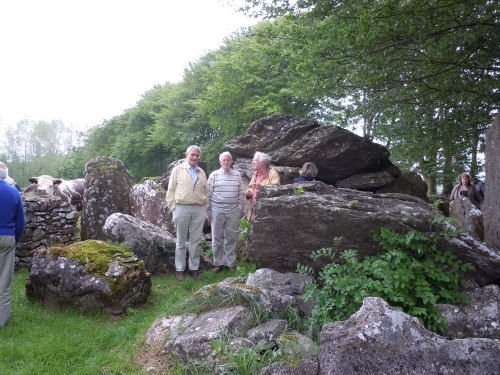
Labbacallee
This is a must see tomb for anyone interested in archaeology as is the entire Glanworth district. It was with great difficulty and after many questions that the party moved on.
The Society members were greeted at Garryvoe Hotel by Andrezej Srama Deputy General Manager. Following a prompt check-in a beautiful hot luncheon was quickly served and after a little tipple the party were energised sufficiently for the short trip to Youghal. On arrival at the Heritage Centre in Youghal the party was met and greeted by Siobhan Sheehan and by Sheila Loughnane who was the Society’s guide for the duration of the visit. Once inside the heritage Centre (from the torrential rain) Sheila gave a step by step account of the exciting history of Youghal bringing to life the town’s fascinating past via the many dramatic images, models and artefacts within the Centre. Sheila spoke about the Gaelic Irish, Viking traders, the Norman settlers and personalities such as Sir Walter Raleigh, Robert Boyle, first Earl of Cork and of course Oliver Cromwell, all of whom contributed one way or another to the town’s eventful history. The Society members heard that the English born Richard Boyle arrived in Ireland in 1588 with little money and lots of ambition, however, his marriage in 1595 to an heiress brought him wealth as did the purchase of the Raleigh’s estates for £1,500. Boyle proceeded to develop the production of pig iron, charcoal, rich iron ore deposits, water power and the port for exporting various commodities. The various religions, including Roman Catholic, Church of Ireland, Quakers, Huguenots, Presbyterians and Methodists also made a major contribution to Youghal’s development. This picturesque town is located on the estuary of the Blackwater River and the name Youghal is derived from the Irish word – Eochaill which means ‘yew wood’, obviously, from its once wooded hinterland. From the earliest times Youghal has been linked to the religious aspect associated with both Ardmore and Lismore dating back to the 5th century.
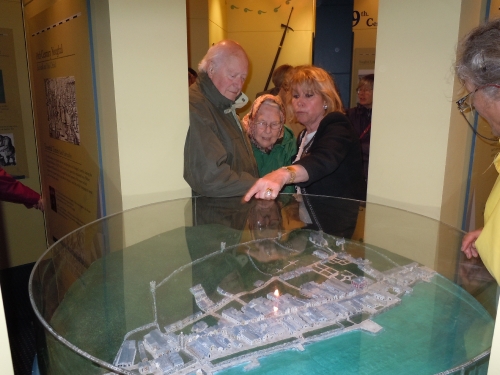
Sheila Loughnane pointing out various aspects of Youghal to members Mary Shackleton, Andrew Ogden & Mary Kirby.
Following on from the Heritage Centre, Sheila Loughnane conducted a coach tour of the town taking in most of the important landmarks of Youghal’s Heritage Trail including:
- The Exchange:
Constructed in 1672 to provide for the civic functions of the town, re-built in 1753 and replaced by the present Court House in 1847 as part of famine relief works.
- Water Gate:
Built in the 13th century as access through the town wall to the docks but better known as Oliver Cromwell’s Arch and the place from where he left Ireland in 1650.
- Clock Gate:
Its tower structure makes it one of the best known features of the town, built in 1777, used as a prison until the mid-19th century and during the rising of 1798 several members of the United Irishmen were hanged from the windows of the tower.
- The Red House:
Built in the early 18th century using red brick for a local wealthy landowner and designed by the Dutch architect, Leuventhen. This structure is reputed to be the only example of a Queen Anne style town house still in use in Ireland.
- Tynte’s Castle:
A 15th century Norman tower and owned by Sir Robert Tynte in the early 17th century. Tynte married the widow of the poet Edmund Spenser.
- Boyle’s Almshouses:
These houses were built in 1610 by Richard Boyle, first Earl of Cork, for six old soldiers who were to receive a pension of £5 per annum and later extended to include widows. Some modification occurred in 19th century and they are now private residences.
- Myrtle Grove:
This house was once the home of Sir Walter Raleigh when he was resident in Youghal. Purchased in 1602 by Richard Boyle and is currently privately owned. This is a fine example of Elizabethan architecture, however, in urgent need of conservation works if the building is to survive much longer.
- St. Mary’s Collegiate Church:
Built in 1220 with extensions added in both the 14 and 15th century and is one of the few churches of this period still in use and a fine example of medieval church architecture. It was just fascinating as Sheila brought the Society members through this building’s remote antiquity. So much so, that it is only possible to list a few aspects from this visit. The site itself being one of the oldest Christian sites in the country devoted to religious worship from pre-Christian times is now a National Monument. The Gothic arches, wood carvings, baptismal stone font and the magnificent 12th century roof trusses of the Great Nave which have been carbon dated to 1135 are all a privilege to see. Richard Boyle, who was created Earl of Cork in 1620, renovated the Church after the damage caused during the Desmond rebellion in the late 16th century. He also built an elaborate monument for himself against the wall in the south transept, demonstrating his status and connections. The monument consists of a figure of Boyle with his first wife on one side and his second wife on the other together with some of his fifteen children.
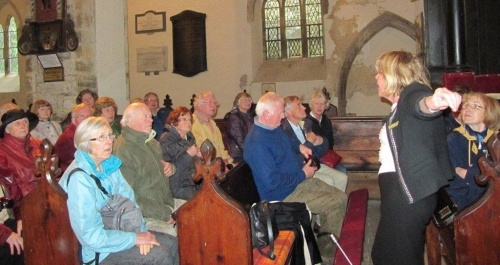
Inside St. Mary’s Collegiate Church
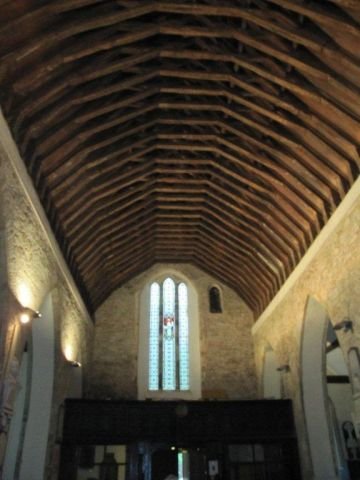
The 12th Century Roof Trusses
Due to the additional time taken facilitating the Society members interest in the history of Youghal, particularly in St. Mary’s Collegiate Church, added to by the inclement weather, it was decided not to proceed with the planned visit to Ardmore for health and safety reasons.
Day 2 Friday 15th June:
The day began with a most memorable visit to the picturesque town of Lismore. Ms. Alice O’Donoghue tour specialist with the Lismore Heritage Company greeted the Society on arrival and acted as chief guide for the day. First on the agenda was a surprise private visit to Lismore Castle. The Castle is not open to the public; however, the County Kildare Archaeological Society was honoured by the kind invitation of the Duke of Devonshire and his son, Lord Burlington for a private visit to the Castle. The Castle at Lismore dates back to the twelfth century and was later handed over to the Church for use as an Episcopal residence. Around 1589 the infamous Archbishop Miler McGrath sold the Manor, See Lands and Castle to Sir Walter Raleigh who in turn, sold Lismore along with over 40,000 acres to Richard Boyle (later first Earl of Cork) in 1602 for £1,500. Sir Walter never resided at Lismore. Richard Boyle together with his family moved residence from Youghal to Lismore in 1620 and his son Robert, of Boyle’s Law fame was born in the Castle. Lady Charlotte Boyle, daughter and heiress of the fourth Earl of Cork, at the tender age of 16, married William Cavendish, fourth Duke of Devonshire in 1748 and on her death in 1753, Lismore Castle became the Irish home of the Dukes of Devonshire right up to the present day. The Castle is designed in Gothic style, while the gardens, laid out over eight acres inside the seventeenth Century outer walls retain much of their original Jacobean form. In recent years, the Castle has been lovingly and extensively restored and upgraded by successive Dukes but the historic charm remains intact giving the entire area such an idyllic setting.
On arrival the Society was warmly greeted on behalf of the Duke of Devonshire by the Manager, Denis Nevin. Denis gave a wonderful talk on the history of the Castle including the discovery of a box hidden in the Castle walls in 1814 which contained the famous Lismore Crozier dating to the early twelfth century and the historic Book of Lismore which is a vellum manuscript dating back to the fifteenth century. Incidentally the manuscript which is a repository of a whole range of stories and histories from the fifth century onwards including reference to St. Brigid and the Curragh. Denis spoke about the contribution of the Devonshire family to Lismore and the esteem in which they are held in the local community. This aspect was evident during the Civil War, that despite occupation and bullet marks, unlike Mitchelstown, Lismore Castle was spared from burning or destruction. Denis talked about the people who lived there over the years including Adele Astaire, sister of Fred Astaire, who was married to Lord Charles Cavendish (second son of the ninth Duke) and lived in the Castle from 1932 until her husband’s death in 1944. During this period and afterwards Fred Astaire made many visits to Lismore. President John F. Kennedy also visited Lismore, his sister, Kathleen, married William Cavendish (eldest son of the tenth Earl and uncle of the current twelfth Earl) who was unfortunately killed in action in World War two a few months after his wedding in 1944. Kathleen herself was killed in an airplane crash in 1948. Outlining the commercial aspect, Denis explained that while Lismore Castle itself is not open to the public, the lovingly maintained public gardens are open during the summer months, as is the west wing of the Castle which houses a contemporary art gallery. Meanwhile the Castle itself is available at commercial rates for exclusive groups of people from all over the world including princes, politicians, heads of state, writers, film makers etc. to enjoy a luxurious home from home in one of Ireland’s most spectacular and magical castles.
There was much excitement as Denis guided the Society members through this 800 year old castle, the luxury and elegance of the nineteenth century decor magnificently maintained combined with modern additions with the various rooms lavishly furnished. Spectacular views can be seen of the Blackwater Valley with the Knockmealdown Mountains in the background. The work of Pugin can be seen all around, in the furniture and in the magnificent Pugin Hall. Time and weather conditions did not permit an in-depth tour of the Gardens, however, a wonderful time was had by all. Reflecting on this the Society’s President, Con Manning, expressed his and the Society’s sincere thanks to the Duke of Devonshire and Lord Burlington for kindly permitting the visit. Hugh Crawford presented a copy of the Society’s DVD and current Journal to Denis Nevin for the Castle’s Library and he thanked Denis in a personal capacity for all his help in the initial preparations for the Society’s visit.

Denis Nevin sharing information with Hugh and Con
The members followed the visit to the Castle with a beautiful luncheon at the Lismore House Hotel and afterwards the party visited Lismore Heritage Centre to be greeted again by Alice O’Donoghue. The story of Lismore and the town’s illustrious past, starting with the arrival of St. Carthage in 636, including monastic Lismore, Vikings, Normans, Sir Walter Raleigh and Lismore Castle all is told in an award winning multi-lingual, audio-visual presentation narrated by Niall Toibin. While a considerable amount of this information had already been given by Denis at the Castle, nevertheless, it was an opportunity for the members to put it all in context. The adjoining exhibition galleries present historic figures that shaped Lismore Town through the ages and a new exhibition space dedicated to the life and works of Robert Boyle ‘The Father Of Modern Chemistry’ and author of ‘Boyles Law’. The town has been a hub of Irish life since medieval times when St. Carthage founded a monastery there in 636, however, the growth of Anglo-Norman influence during the late 12th century marked the decline of the monastery. The town of Lismore, it is said, gets its name from two Gaelic words; Lis meaning a fort and mor meaning big and derived from the round hill or great fort to the east of the town.
Following on from the Heritage Centre, Alice O’Donoghue escorted the members on the short walk to St. Carthage’s Cathedral. The members were welcomed to the Cathedral by the captivating Catherine Draper on behalf of her husband the Very Rev. Paul Draper who had to perform unexpected duties elsewhere. Catherine guided a tour of the Cathedral’s Library where there is some wonderful ecclesiastical material, personal collections and a Bible written in old Irish. Alice on the other hand, led a tour of the Cathedral itself which is a cruciform structure with a variety of architectural styles and dedicated to St Carthage. The different features which Alice highlighted included:
- The entrance gates, the wide cobbled path and line of lime trees:
The gates dates from 1811 while the cobbles date to 1726.
- Burne-Jones Stained Glass Window:
The work of pre-Raphaelite artist Burnes Jones is the only one of its kind in Ireland and depicts justice and humility.
- Chancel:
This part of the cathedral was re-built around 1811 with the elaborate decorated ceiling stands out.
- Stone Pulpit:
Dating to the nineteenth century of French stone and decorated with marble from Connemara, Kilkenny and Donegal.
- St. Columba’s chapel:
Named after St. Columba or Colmcille the Donegal saint who visited Lismore monastery during his tour of Ireland and who later left Ireland to establish the monastery in Iona.
- Romanesque Arch and Oak Pulpit:
This arch in the Romanesque style is one of the oldest parts of the Cathedral dating to the twelfth century. Nearby is the magnificently carved eighteenth century solid oak pulpit.
- McGrath Tomb:
This imposing stone tomb is a wonderful example of sixteen century stone carvings including the twelve apostles and saints Catherine, Cartagh and Patrick. John McGrath and his wife Katherine had it built during their lifetime for later use.

Alice O’Donoghue speaking in the Cathedral
There were so much interesting features and artefacts to see, however, time was running out and Con Manning availed of the opportunity to thank Catherine Draper, who had been called in to represent the Dean at the last minute, and the Church community for the wonderful reception given to the Society members on their visit to the Cathedral. Prior to departure from Lismore, Hugh Crawford thanked Alice O’Donoghue for her help and enthusiasm over many months in assisting him in the planning of this most successful and memorable visit to Lismore.

Catherine Draper with Con and Hugh
Day 3 Saturday 16th June
Following breakfast and checkout the Society members departed to make the short journey to Cobh. Leaving the Garryvoe Hotel was tinged with a little regret at leaving a most relaxing atmosphere and the generous hospitality enjoyed during the stay not to mention the marvellous breakfasts and dinners each day. The attention to detail, presentation and cooking of food and the speed of both checks in and out is a credit to the management and staff of the Garryvoe Hotel. On departure, Hugh Crawford thanked Andrezej Srama, the Deputy General Manager and his staff, for the extraordinary effort made to make the Society’s stay such a wonderful success.
Cobh is situated on Great Island which is the largest of islands in Cork harbour and joined to the ‘mainland’ by a bridge close to its sister island Fota. Formerly known as Cove and renamed Queenstown in 1850 to commemorate the visit of Queen Victoria it was changed again in 1922 to the gaelic form of Cove – Cobh. Once a major transatlantic departure point as over 40% of the six million Irish people who emigrated to America between 1848 and 1950 left from Cobh. When crossing over the most picturesque bridge to Great island, one of many Martello towers built on the shores of Cork harbour during the Napoleonic wars can be observed, while to its left is a fine specimen of a fifteenth century towerhouse. Regarding this towerhouse, the coach guides on the day were unable to elaborate so it is important to confirm that it is known as Belvelly castle, one of many that dominated the medieval landscape from 1400 onwards and built by the Fitzgeralds.
The first stop in Cobh was at the magnificent St. Colman’s Cathedral which took 47 years to build 1868 – 1915. However, it commenced use first in 1879 and this major ecclesiastical building project was completed in 1915 when the building of the 300 feet high spire was completed. It has a carillon of 49 bronze bells expertly tuned providing Cobh with a tradition of sacred music. Maire Weedle gave a brief talk later on the musical significance of this. The Cathedral is built in the form of a Latin cross and its exterior is of Dalkey Granite with dressing of Mallow limestone in French Gothic architectural style under the guidance of the architects Pugin (the younger), Ashlin and Coleman. In the Nave, the Gothic grandeur of the interior together with the massive marble pillars, arches and delicate carvings can be seen. In addition there is the high Altar designed by Ashlin, side chapels, the Austrian Oak Pulpit, the famous Organ and the magnificent stained glass windows.
Outside the Cathedral there is an outstanding seascape of Cork harbour including Haulbowline island the base of the Irish Naval Service, Spike Island and Crosshaven, all on the west side of the harbour, while on the east side, Roches Point, Fort Davis military fort, Whitegate oil refinery and Ahada power station can be seen.

Oliver and Seamus view the landscape
The next stop was the Cobh Heritage Centre based at the restored disused part of the old Victorian Railway Station. Here the Society members were able to enjoy the highly imaginative multimedia exhibition which explores the conditions on board the convict ships and the emigrant ships right up to the luxury of the Titanic. It details the Titanic’s pickup of 123 passengers at Cobh on her final port of call before embarking on her ill-fated maiden voyage with a total of 1,308 passengers and 898 crew, of this figure, 1,500 would subsequent perish. Only 44 of the Cobh passengers survived. A selection of Fr. Browne’s well known images from the ill-fated ship are displayed. Several other notable ships are referred to, including the sinking of the Cunard Liner Lusitania, which perished off the head of Kinsale in 1915, following an attack by a German submarine. The survivors were ferried to Cobh and provided with assistance. The attack resulted in the loss of over 1,198 lives and they are remembered by the Lusitania memorial in Casement Square.
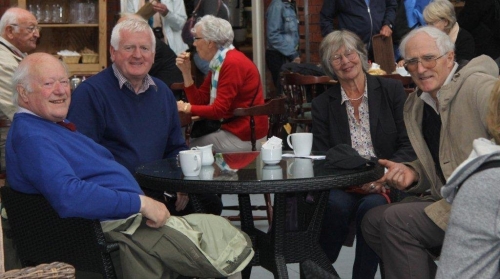
Relaxation
Just outside the Heritage Centre is the statue of Annie Moore and her two brothers who emigrated from Cobh. Annie was made famous by being the first emigrant to the U.S.A. to be processed in Ellis Island, New York on 1 January 1892 and there is a similar statue in her honor in Ellis Island. Some members paid a visit to the nearby local museum located in the former Presbyterian Church overlooking the Harbour which contains cultural, social and maritime history of Cobh and the Great Island together with a genealogical reference section where visitors can do their own research. Some members found time also to visit the original White Star Line offices which now houses the recently opened Titanic Experience visitor attraction centre. Outside of this Centre is the jetty where the 123 passengers who boarded the Titanic at Cobh got on the tenders that brought them to the great ship which had anchored in the harbour for its maiden and only voyage to America. Here in the Centre, with the use of modern technology, there is the opportunity to retrace the final path of these unfortunate passengers on their fateful journey and to visualise their experiences as they boarded and sailed away in the greatest ship afloat of their generation.

The Annie Moore Statue
Time had again run out and the Society members made their way to Gilbert’ Restaurant in Pearse Square, Cobh, to celebrate what was unanimously described as a ‘memorable tour’. The Society was formally welcomed to Cobh and the Restaurant by the charming Ann Daly, one of the proprietors. Hugh Crawford thanked Ann for her help to him over recent months in planning the visit to Cobh and in drawing up such a wide selection menu. Throughout the stay no effort was spared in making the party feel comfortable and a freshly cooked gourmet luncheon with a complimentary glass of wine or mineral was served from a wide ranging menu. On leaving the Restaurant, Con Manning on behalf of the Society thanked the chef and the entire staff for such a wonderful meal and service.

The Cathedral & Gilbert’s
Before leaving Cobh, Finbarr Lambert gave a short talk on the military/naval importance of Cobh and the fortification and defences of Cork harbour especially during the Napoleonic wars in the early nineteenth century. Pointing out the striking storehouses on Haulbowline island, the fortifications on Spike Island and those at the entrance to harbour, which together, made the base as strategically important, if not more, that the like of Portsmouth. In the mid nineteenth century a major naval dockyard for the servicing of naval ships was established at Haulbowline. It was also an important naval base for British and American navy during World War 1.
On leaving Cobh on the homeward journey Society members got a close up view of a gigantic cruise ship which had docked that morning. There was considerable interest in the tiny village of Rushbrooke on the outskirts of Cobh with its prime example of Victorian architecture which with the picturesque Passage West just across the narrow channel as a backdrop makes for a most pleasant departure from Cobh. Travelling on the Fermoy bye-pass there was an opportunity to get a different view of the Blackwater valley landscape with the famous Carrigabrick disused railway viaduct in the background. This viaduct was made famous when used for a major scene in the 1966 film, The Blue Max. This involved the stunt pilot flying a number of times between the narrow and wide spans with only a few feet to spare and all done while the railway was still in use. There was a short stop in Cahir which provided an opportunity for a group photograph with the magnificent Cahir Castle in the background.
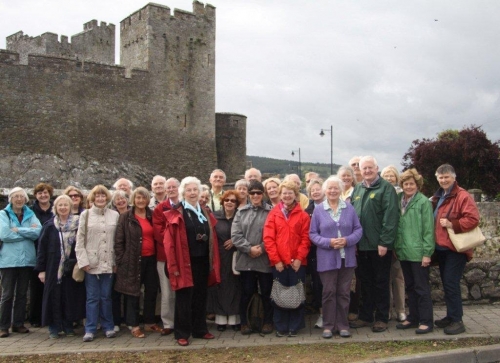
Group at Cahir Castle
(Photographs are by Hugh Crawford, Peter Glennon and Finbarr Lambert.)
Hugh Crawford



